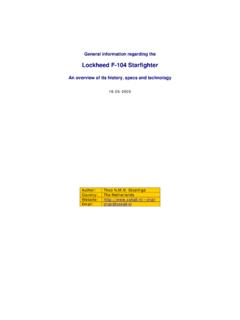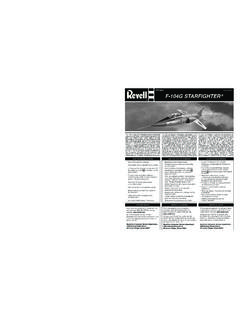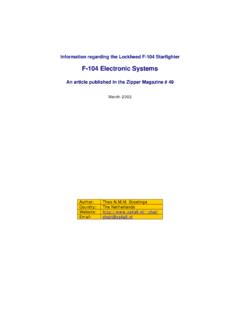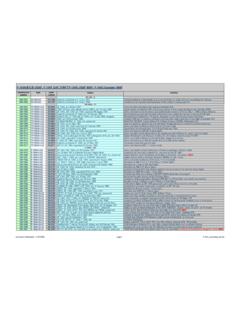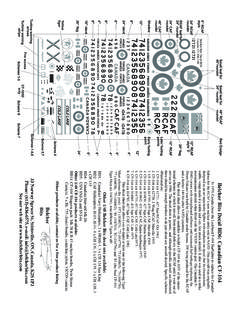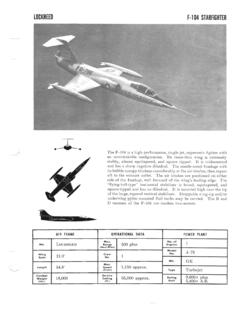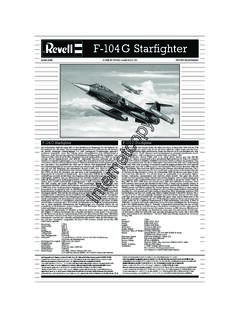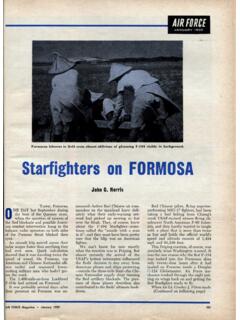Transcription of F-104 Airfield Requirements - rolfferch.de
1 Information regarding the lockheed F-104 starfighter F-104 Airfield Requirements An article published in the Zipper Magazine #53 March-2003 Author: Theo Stoelinga Country: The Netherlands Website: ~chair Email: Table of contents Table of 2 1. F-104 Airfield Requirements .. 3 Take-off runway length 3 Wind velocity and 3 Take-off gross weight .. 3 Airfield elevation .. 4 Temperature 4 Runway surface factor .. 4 Wind factor .. 4 Take-off over 50-foot 5 Landing runway length Requirements .. 5 Runway strength Requirements .. 5 Runway strength rating systems .. 5 Soil surface limitations .. 6 1.
2 F-104 Airfield Requirements The quality and characteristics of available airfields will have a direct bearing on the starfighter squadron s operational plan. Factors of runway length, surface condition, load carrying capacity, elevation, and climatic environment will all have to be considered. The starfighter s runway Requirements are quite modest at intermediate gross weights. For example, at a weight of 25,000 pounds (11,340 kilograms), the F-104 take-off ground roll is 4,000 feet (1,219 meters) for standard day, sea level, and zero-wind conditions. The starfighter can also be operated from steel, pierced-plank, surface matting runways at take-off weights up to 25,000 pounds (11,340 kilograms). The F-104 can operate from asphalt runways at its maximum gross weight.
3 Take-off runway length Requirements Since take-off runway length Requirements for any airplane differ over a wide range as a function of several variables, it is not possible to arbitrarily specify a minimum or maximum runway length that will apply to all conditions. The variables, which influence runway Requirements , are: Take-off gross weight Airfield elevation Ambient temperature Runway surface slope and drag Wind velocity and direction The variables which affect F-104 take-off roll distances are summed up in a chart which can be found in the F-104 flight manual. Take-off gross weight Take-off gross weight influences runway length Requirements in several ways. One is of course the aerodynamic lift, which must equal weight before the aircraft can lift off.
4 Since lift is a function of speed, take-off distance is a function of speed. At lighter weights less speed is required because less lift is required. The distance required to accelerate to take-off speed is less at lighter weights for two related reasons. First, it requires less distance to accelerate to a lower speed, and second, a lighter weight accelerates more rapidly. Maximum thrust is the usual power setting for take-off because of the substantial reduction in take-off ground roll compared to military power take-off distances. This allows the starfighter to accelerate quickly to its best climb speed after lift off. The difference between a normal and a maximum performance take-off is the speed at which the airplane is rotated. For a maximum performance take-off the F-104 is rotated at a lower indicated air speed, thereby attaining the advantage of increased lift components earlier in the take-off roll.
5 A pilot must maintain a high level of proficiency to consistently attain maximum performance distances (minimum take-off roll). Airfield elevation Take-off ground distances increase as a function of Airfield elevation, if all other factors remain constant. The reason is that aerodynamic lift and engine thrust both decrease as a function of decreasing barometric pressure at any given subsonic air speed. The fact that aerodynamic drag also decreases with decreasing barometric pressure does not compensate for the thrust and lift losses at take-off speeds. The approximate effect of Airfield altitude on take-off distance may be calculated by increasing the take-off distance by 7% for each 1,000 feet (305 meters) of Airfield altitude above sea level.
6 Temperature factor Engine thrust varies as a function of ambient temperature, and therefore temperature influences take-off distances. The sea level, standard-day take-off distances decrease at lower temperatures and increase at higher temperatures. The approximate effect of ambient temperature on take-off distance may be calculated by decreasing or increasing the sea level, standard-day, take-off distance by 6% for each 10 F (5,5 C) variation from the standard 59 F (15 C) temperature. Runway surface factor Runway slope and surface drag also influence take-off distances, because they have an effect on the thrust required to accelerate the aircraft to take-off speeds. The standard-day, sea level, ground roll distances depicted for the starfighter are predicated on a smooth, level, dry runway surface.
7 If the squadron is based on a Airfield that slopes along its length or one that has a surface sufficiently rough to increase the rolling friction, then some correction to F-104 take-off distance data must be applied. It is difficult to derive numerical values for predicting the influence of surface drag variables. However, thee tend to be similar for all types of aircraft. Therefore any percentage change in take-off distances being used with other jet fighters at a given base should be applied similarly to the F-104 . Another factor to take in consideration is runway drainage. If the runway surface has insufficient camber, rainwater will stand on the surface, causing an increase in drag and take-off distance. Wind factor Wind velocity and direction have an influence on take-off distance because the speeds required for rotation and lift-off are air speeds rather than ground speeds.
8 Taking off into a head wind of 20 knots requires 20 knots less ground speed. This reduces the take-off distance by the length required to accelerate through the last 20 knots. Of course if take-off is down-wind, the required distance is increased. Take-off over 50-foot obstacle The preceding discussion of take-off distances has considered ground roll only. In practice, the runway length is greater than ground roll distances in order to provide stopping distance for an aborted take-off. Ideally the runway should be long enough to safely contain an aborted take-off right up to the lift-off speed. A rule of thumb for determining this distance is to increase the ground roll distance by 75%. However, such runways are not always available, and are not in fact necessary.
9 It is possible to establish a go-no go checkpoint along the runway, short of the lift-off point. At this check point the pilot can determine if the required acceleration is being achieved, and if not, he can abort the take-off at this point with sufficient stopping distance remaining. The Flight Handbook outlines the procedure for locating the go-no go checkpoint for the runway being used. There are two general practices in common use for calculating desired runway lengths. One practice, mentioned previously, is to increase the take-off ground roll distance by 75%. Another practice is to use the take-off distance over a 50-foot ( meter) obstacle as the determining criteria for desired runway length. Generally both these methods are applied for the average temperature and wind experienced at the runway location, and they include the effects of runway altitude and slope.
10 Landing runway length Requirements Landing roll distance is not a critical factor when evaluating runway length Requirements for the starfighter . At normal weights, the F-104 can be landed in less distance than required for take-off. The bleed-air boundary layer control system for the trailing edge flaps, the anti-skid braking system, and the deceleration parachute installation-all help to make possible the starfighter s short landing distances. Runway strength Requirements In addition to having adequate length, the runway and its adjacent taxi strips and parking areas must be able to withstand the weight loads of the aircraft. All Air Forces are placing increased emphasis on the ability of their fighters to operate from unimproved surfaces.
